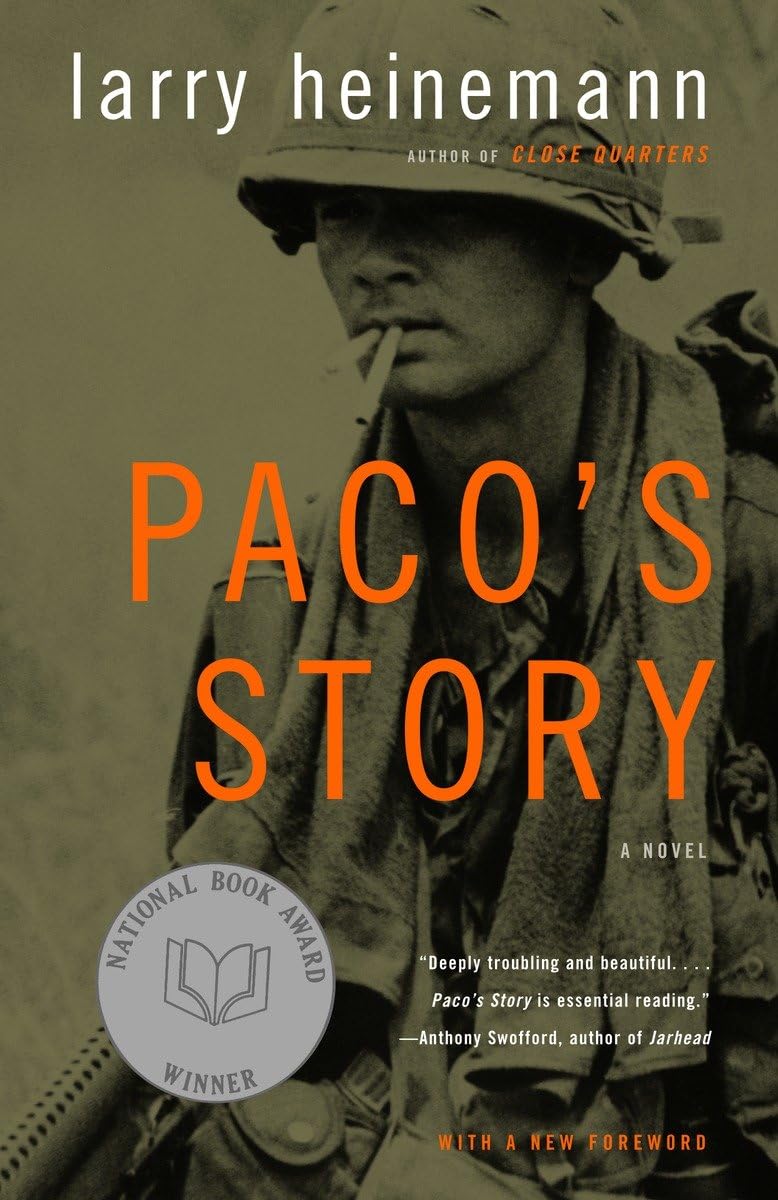Spoilers:
- Paco is the only survivor.
- Paco is haunted by dead soldiers.
- Town’s residents ignore Paco’s existence.
- Paco struggles with his war traumas.
- Paco ends up working at a diner.
Paco’s Story: A Statistical Overview
A stark look at the statistics surrounding “Paco’s Story” by Larry Heinemann.
Basic Info
- Author: Larry Heinemann
- Published: 1986
- Publisher: Farrar, Straus and Giroux
- Genres: Fiction, War, Historical
Acclaim
- National Book Award: 1987
- Reception: Mixed reviews; praised for raw depiction of war
Sales Figures
Themes and Motifs
- War trauma
- Survival and healing
- Isolation
Critical Analysis
- Style: Gritty and unfiltered narrative
- Pacing: Slow, reflective
- Character Development: Focused on deep psychological impact
“Paco’s Story” by Larry Heinemann is a poignant narrative that defies conventional storytelling. A unique voice in the modern literary canon speaking through a Vietnam War veteran, it smartly negotiates past reservoirs of trauma and the ongoing quest for survival. Heinemann vividly crafts the character of Paco, whose pain captured through a rich prose is surrealistically confronting.Instead of glorifying war, Heinemann weaves a haunting story of survival, guilt and mental disruption. The novel is gripping in its raw portrayal of the post-war experience. It covers endurance, unraveling a tale not of a hero but of an emotionally damaged survivor whose world has been irrevocably changed. The haunting memories of life in Vietnam seep into the corners of Paco’s daily existence, embedding the readers in an unsettling encounter with war’s aftermath.”Paco’s Story” is infused with challenges to readers’ perceptions of heroism, triumph, and guilt. Heinemann delves beneath the mere recounting of war happenings; he brings forth the complexity of dealing with constant, destructive reminiscences, highlighting the unseen war waged within a survivor’s soul. The story is a rich tapestry woven with paradoxes of homecoming: rather than a victor’s welcome, Paco ends up ostracized in his own society.A compelling exploration of reality versus illusion and collective memory versus personal experience, it’s a panoramic view of the human psyche under the wreckage of war. Heinemann’s gift of storytelling relishes in the exploration of the often unspoken realms of despair, lucidly illuminating a heart-rending image of consequence and survival. Simultaneously brilliant, insightful, introspective, emotional and provocative, “Paco’s Story” astutely unravels the layered nuances of the human condition after war – the living embodiment of what remains when the rest of the world moves on.
Introduction to Paco’s Story
“Paco’s Story,” written by Larry Heinemann and published in 1986, is a hard-hitting novel that dives into the aftermath of the Vietnam War. It’s famed for capturing the grim reality faced by war survivors. The narrative centers on Paco Sullivan, the sole survivor of a vicious attack on his unit. His struggle through physical and emotional scars offers an unfiltered glimpse into post-war life.
Interesting Facts and Speculation
One intriguing element of the book is its narrative style. The story is told by the spirits of Paco’s fallen comrades, an unusual and chilling choice that underscores the war’s lingering haunt. Some speculate that this narrative strategy reflects Heinemann’s attempt to amplify the voices of the unheard soldiers. Also, Heinemann drew heavily from his experiences as a Vietnam veteran. This adds a layer of realism that some readers find gripping, while others see it as harrowing.
Public Perception Over Time
Upon release, “Paco’s Story” divided critics. It won the National Book Award, which spurred arguments about whether war stories should focus on trauma rather than heroism. Early public perception was polarized; some praised its authenticity, while others critiqued its bleakness. Over time, however, it gained recognition as a poignant narrative of the Vietnam War’s impact. Today, it holds a place in literary discussions for its raw portrayal of survival, often studied in the context of war literature.
Discussion on its narrative style remains active.
Bizarre and Interesting Aspects
- The ghosts narrating the story provide a unique perspective.
- Heinemann’s detailed depiction of post-war trauma stands out.
- Winning the National Book Award stirred controversy, attracting both praise and critique.
Paco’s Story: The Beats
Surviving Hell: Paco Sullivan is the lone survivor of a Vietnam War firefight, forever marked by the physical and mental scars.
Coming Home: Discharged, Paco hits the states and lands in a small town, trying to stitch a life back together amidst a landscape that doesn’t get it.
The Daily Grind: Paco starts washing dishes at a local greasy spoon, the Lanikai, where the mundane becomes his new battleground.
Ghostly Companions: The fallen soldiers from his unit haunt him, narrators to his newfound world, invisible guides through his post-war reality.
Small Town Stir: Paco attracts attention – a mixed bag of curiosity, admiration, and the uncomfortable kind of notoriety you get from surviving when others didn’t.
Improbable Friendships: Finds unlikely camaraderie with a few locals – a cook, a waitress, and a damaged veteran – who see past the scars to the man still standing.
Romance on the Horizon: A mute emotional bond forms between Paco and Shirley, a waitress at the Lanikai, as they navigate their shared and unspoken burdens.
Healing and Haunting: The slow dance of recovery as Paco confronts his memories, the ghosts of his past, and the possibility of moving forward.
Community Clash: Not all are welcoming, tensions escalate, leading Paco to grapple with both his internal demons and external adversaries.
Epiphany: A combustible mix of trauma and small-town dynamics forces Paco to a breaking point, pushing him toward a moment of clarity about his path forward.

Analyzing Paco’s Story Opening
The opening of “Paco’s Story” sets the stage effectively. It begins with a stark reflection of war, introducing readers to Paco’s troubled mind. His internal struggles and the harsh realities of life in a combat zone create an immediate tension. This creates an emotional impact that draws the audience in. The setting is grim, echoing the chaos he endures. The tone is direct and unflinching, establishing a sense of urgency right from the start.
Story Formula Breakdown
- Character Introduction: Establishes Paco’s character and his psychological state.
- Setting: The backdrop is crucial. The backdrop of the Vietnam War is not just a setting but a character in itself, shaping the protagonists’ experiences.
- Conflict: Internally driven; Paco battles his memories and guilt as well as external dangers.
- Theme: Explores survival, guilt, and redemption.
- Resolution: Throughout the story, Paco seeks some form of resolution, though it remains ambiguous by the end.
Character vs. Story Driven
The story is more character-driven. Paco is the focal point, and readers follow his journey through his psyche. The events are significant but largely serve to illustrate his inner conflict. External plot points mirror his emotional state rather than drive the story forward. The focus remains consistently on who Paco is and how he responds to his surroundings.
Memorable Character Elements
What makes Paco memorable is his depth and complexity. He is not just a soldier; he is a deeply flawed human being wrestling with pain, guilt, and trauma. His backstory unfolds gradually, revealing layers of his character. The development of his psyche and the vivid details of his experiences allow readers to connect with him personally. His reflections on love and loss resonate long after the story ends, making him a lasting figure in literature.
Main Characters
- Paco: The protagonist, a soldier haunted by his experiences. He struggles with PTSD and battles his inner demons throughout the story.
- Lupe: Paco’s love interest. She represents hope and a life outside of the nightmares of war. Her memories serve as both comfort and torment to Paco.
- Other soldiers: Various companions in the war showcase different reactions to trauma, highlighting the diversity of coping mechanisms.
- Family figures: Brief appearances that expose Paco’s roots and emotional ties, enhancing the theme of loss.
Story Flow Template
Create your story following this structure:
- Opening Scene: Introduce character and immediate conflict. Set the emotional tone.
- Background: Briefly outline the character’s past and struggles to give context.
- Main Conflict: Define the story’s central problem or struggle. Focus on the character’s inner turmoil.
- Secondary Characters: Introduce supporting characters who influence the protagonist’s journey.
- Climactic Moment: Present the peak of the character’s emotional conflict. Make it relatable yet intense.
- Resolution: Show the outcome. It can be ambiguous, reflecting real life and emotional complexity.
Simple Summary of the Story
At its core, “Paco’s Story” is about the psychological aftermath of war. It delves into the trauma of soldiers, particularly through the eyes of Paco, who struggles with his haunting memories and seeks to find peace amidst the chaos around him. The novel explores themes of love, loss, and the quest for redemption, ultimately revealing how deeply the scars of war can run.
Paco’s Story Analysis
Inciting Incident
The inciting incident in “Paco’s Story” occurs when Paco, the protagonist, receives a letter inviting him to share his story. This moment propels him into a journey of reflection and ultimately drives the narrative forward. The letter symbolizes hope and the possibility of redemption amid the chaos of his life. It represents a turning point, compelling Paco to confront his past.
Act Structure
The novel is structured in three acts:
-
Act 1: Introduction and Setup
We meet Paco, a man grappling with his troubled past and current circumstances. His environment—marked by violence and poverty—sets the stage for his inner turmoil. Key themes of guilt and loss emerge early on, as Paco navigates his relationships with family and friends.
-
Act 2: Rising Action
As Paco begins to recount his story, flashbacks reveal the traumas he has experienced. His memories serve as a haunting reminder of his failures. Tension builds as Paco faces obstacles in reconciling his past with the present, intertwined with moments of reflection that deepen his character.
-
Act 3: Resolution
The climax sees Paco confront the consequences of his actions and decisions. This moment is critical; it leads him to a choice that determines his path forward. The resolution provides a sense of closure but doesn’t shy away from the reality of his struggles.
Climax
The climax occurs when Paco faces an ultimate confrontation with a character from his past. The emotional capital here is profound. It encapsulates years of built-up regret and longing for redemption. The build-up includes Paco’s increasing anxiety and preparation for this moment, drawing readers into his internal conflict and the weight of his choices.
Tension and Release
The book effectively builds tension through Paco’s internal monologue and interactions with others. Each recollection intensifies the pressure on him, painting a picture of a man at war with himself. Release comes in moments of catharsis, often when Paco allows vulnerability to surface, providing readers with relief from the brooding tension. So, throughout the narrative, tension and release work hand in hand to amplify the emotional stakes of Paco’s journey.

Paco’s Story Ending Explained
The ending of Paco’s Story ties up the threads of Paco’s journey throughout the Vietnam War. After a series of traumatic experiences and losses, Paco finds a sense of closure. He comes to terms with the effects of war, both on himself and those around him. Ultimately, he understands the significance of survival and acceptance of his past.
Writers’ Take on the Ending
Writers might categorize the ending as cathartic. It gives the main character, Paco, a resolution through reflection, marking a shift from chaos to a more stable understanding of his life.
Symbolism and Themes
- Survival: Paco’s acceptance symbolizes resilience in the face of trauma.
- War’s Impact: The ending captures the lasting scars that war leaves on veterans.
- Redemption: Paco’s path to forgiveness mirrors a universal quest for redemption.
Loose Ends and Payoffs
The ending resolves several key points:
- Paco’s confrontation with his past.
- The fate of his comrades and their shared experiences.
- His ultimate understanding of life after war.
Character Development
Paco transitions from a frightened soldier to a man who faces his demons. He learns to live with his memories instead of being defined by them. The ending shows a shift towards emotional maturity and acceptance.
Lessons for Writers
Writers can learn the importance of resolutions that feel earned. The ending demonstrates how characters can evolve through hardship. Conflict leads to growth, and closure should resonate with the reader on an emotional level.
Dialogue Style in Paco’s Story
The dialogue in “Paco’s Story” is raw and gritty, reflecting the struggles of the characters. It captures the reality of their situations, often filled with emotional weight and stark honesty. The conversations are fragmented, mirroring the chaos in Paco’s life.
Examples of Dialogue
Here are a few snippets that illustrate the dialogue:
- “I just want to go home, you know? Is that too much to ask?”
- “Home? What is that anymore? It’s just a place on a map.”
- “You think you can escape? This is it, man. This is your life.”
Quintessential Character Moment
A powerful moment comes when Paco reflects on his past while talking to another character. This exchange shows vulnerability and deep self-examination.
Iconic Lines
Some iconic lines resonate with readers:
- “You can run, but can you hide from yourself?”
- “No one can save you, but you.”
Unique Aspects of the Dialogue
The dialogue is unique because it does not waste words. Every line adds depth to the characters. It avoids clichés, maintaining an authentic voice. The casual speech patterns make the characters relatable.
Dialogue Density
The script is dialogue-heavy, making it central to storytelling. Most character development happens through conversations, not internal monologues or exposition.
Realism of Dialogue
The dialogue feels real. It captures everyday speech, including interruptions and incomplete thoughts. The characters react genuinely to their circumstances.
Lessons for Writers
Writers can learn to:
- Make dialogue reflect character depth.
- Use brevity for impact.
- Ensure every line serves the narrative.
Scene Walkthrough
In a pivotal scene, Paco sits with a friend on the edge of town. They discuss their future. The dialogue flows naturally:
Paco: “Isn’t there more to us than just surviving?”
Friend: “Surviving is all we’ve got right now. Don’t complicate it.”
Here, Paco expresses a desire for meaning, while his friend represents pragmatism. This contrast highlights their differing worldviews and adds tension to the scene. As they speak, the reader feels the weight of their experiences. The dialogue reveals their histories without needing to explain them fully.
Paco’s Story: A Poetic Reflection
In the barren land of exile, a spark—
From the bowels of survival, whispers take flight,
Paco, a name spun in threads of dust and hope,
Dances with shadows, paints with scars.
The world spins silly: a rollicking tide,
Yet wisdom’s weight lies heavy, profound,
Lives of the lost, resides in jest
Where dreams are stolen, like candy from hands.
Behind each smile, a tempest brews,
Paco finds laughter in the cracks of despair,
He knows the stoic dance of rugged days,
A balancing act on a tightrope of fate.
Voices of ghosts tug at his sleeve,
“Remember us,” they chant through the dark,
So he dreams in defiance, a lighthouse’s seam,
A bridge from the wreckage to the boundless light.
Oh Paco!
With every breath, a fire ignites,
Not merely a tale, but an odyssey’s jest,
In absurdity found—the essence of truth.
Unique Writing Lessons from Paco’s Story
Here are insights drawn from Larry Heinemann’s “Paco’s Story” that go beyond basic writing advice.
-
Embrace Uncertainty
Paco’s journey is messy. Life is unpredictable. Reflect that in your writing. Allow characters to stumble and evolve.
-
Use Scarcity of Voice
Paco doesn’t speak much, but when he does, it matters. Choose your dialogue wisely. Less can evoke more.
-
Grief as a Tool
The weight of loss drives the narrative. Leverage deep emotions. Let your readers feel the heaviness, not just observe it.
-
Setting as Character
The environment shapes Paco. Make your settings active. Let them influence your characters’ choices and paths.
-
Non-Linear Storytelling
Paco’s reflections jump between past and present. Break the traditional timeline. Reveal history in fragmented pieces.
-
Symbolism Through Objects
Objects in the story carry weight. Use items to symbolize emotions or backstory. They can convey complex ideas without words.
-
Show, Don’t Tell with Action
Paco’s actions reveal his spirit. Instead of stating traits, illustrate them through what characters do in tough situations.
-
Redefine Strength
Strength isn’t always physical. Highlight different forms of resilience. Vulnerability can be just as powerful.
Larry Heinemann Discography
- Born on the Fourth of July (1976)
- Paco’s Story (1986)
- Skin Deep (1992)
- A Soldier’s Story (1992)
- Black Dust (1996)
- Evergreen (2009)
Writer’s Style
Larry Heinemann’s style is characterized by stark realism and a raw, unfiltered portrayal of war and its aftermath.
Review 1: Excerpt: “Paco’s Story is the powerful anecdote of an unfortunate soldier named Paco Sullivan who is the only survivor of his fire team during the Vietnam War. Heinemann’s powerful use of raw, vivid narration and gruesome imagery further emphasize the grim reality of Paco’s life post-war. The story is a series of failed romances, reconstructed body, and flashbacks from the war. It’s raw, it’s rough, and it involves you in the convoluted world of Paco Sullivan. Heinemann’s story is an emotional journey from start to finish, diving deep into the not-so-prominent topics of war survivor’s guilt, post-traumatic stress disorder, and the failures of the Veterans Administration, among others.”Source: [Goodreads](https://www.goodreads.com/book/show/90804.Paco_s_Story)Review 2:Excerpt: “Heinemann confronts Hansen’s too realistic goals in his novel Paco’s Story … the book is an uncompromising litany of violence … Soldiers ripping open the bodies of enemies, survivors ripping open their own bodies in order to remember and, perhaps, reorder the pieces of a lost past…Paco’s story is harsh, as fragmentary as Hansen might wish it were, but edged with wit, original images, compelling confrontations…and the kind of language that demands more than one reading and, hence, more than one making.”Source: [JSTOR](https://www.jstor.org/stable/40144407?seq=1)Review 3: Excerpt: “Larry Heinemann’s strong and bold new novel of the Vietnam war is manifestly a story of survival and guilt. All the familiar, distressing elements are here: the nightmare scars, something dead in the eyes, whiskey at breakfast, perpetual tears..Heinemann sustains a tone of moral seriousness and a compacted, jumpy style that create uncommon power, strength, and strangeness.”Source: [The New York Times](https://www.nytimes.com/1987/01/11/books/yankee-medico.html)Review 4:Excerpt: “The narrative is ghostly, and themes of guilt, lost time, and randomness dominate. Just as Paco carries physical scars from being blown up, each character carries emotional scars from their war experiences. Paco’s story itself is told by a storyteller who claims to understand everything about Paco and the others, but whose true identity remains a mystery.”Source: [BookRags](https://www.bookrags.com/studyguide-pacos-story/#gsc.tab=0)Review 5:Excerpt: “Paco’s Story is a bitter, twisted tale of deprivation, death, and suffering; a graphic picture of the destructive and dehumanizing force of war… The very intensity of the book’s focus makes it an experience that is not easily forgotten…The novel is not so much about war as it is about the casually cruel aftermath of war.”Source: [eNotes](https://www.enotes.com/topics/pacos-story)
- Paco’s Story: A Novel: 9781400076833: Heinemann, Larry: Books
- Paco’s Story by Larry Heinemann | Goodreads
- Review: Paco’s Story by Larry Heinemann | Diary of an Eccentric
- On Larry Heinemann – Time Now: The Wars in Iraq and Afghanistan …
- Paco’s Story – Wikipedia
- In Defense of ‘Paco’s Story’ – Los Angeles Times
- Paco’s Story – National Book Foundation
- R.I.P., Larry Heinemann – Mad Blog Media
- Facts & Fiction – Larry Heinemann
- Larry Heinemann – Jeffrey A. Wolin




Leave a Reply